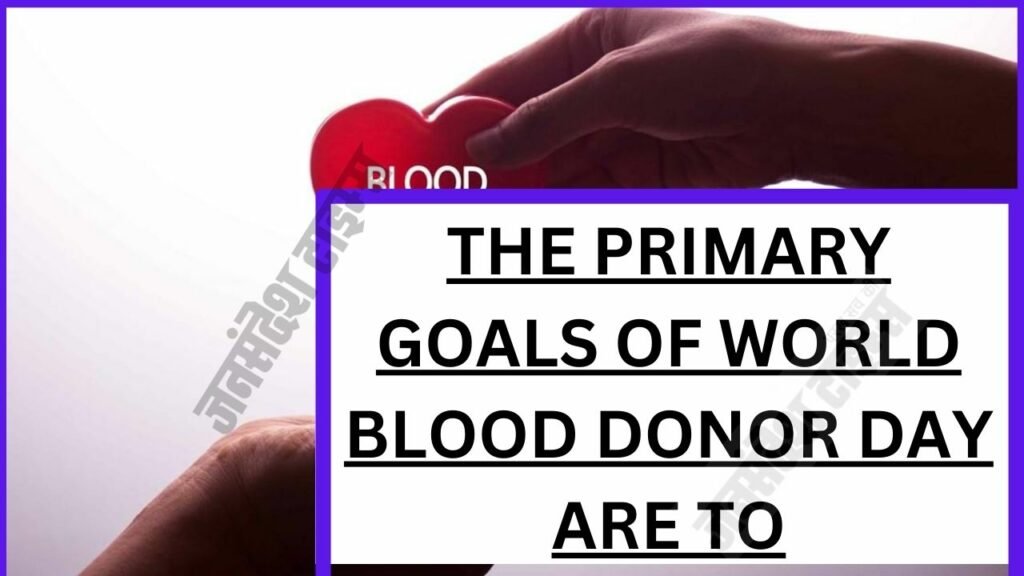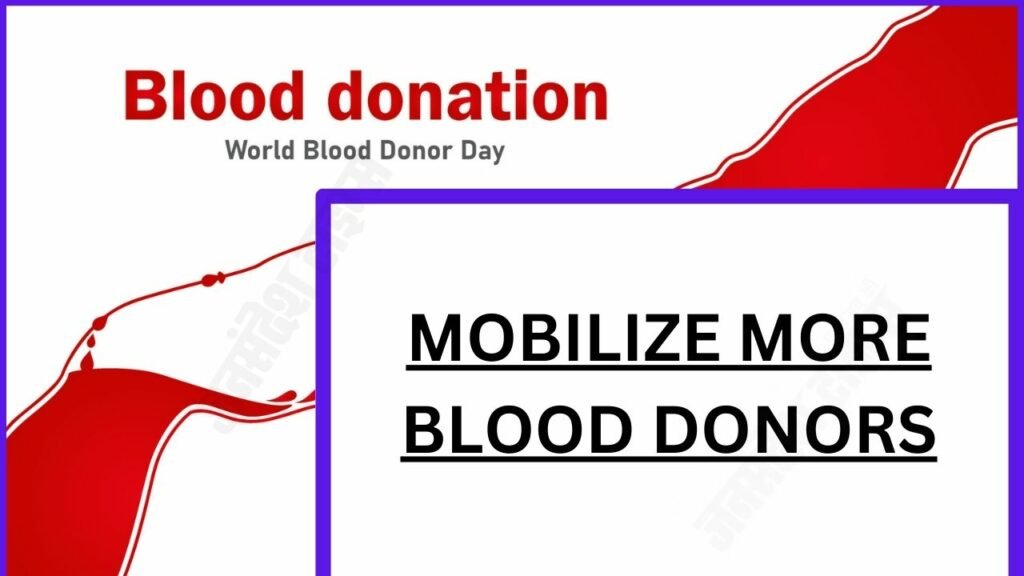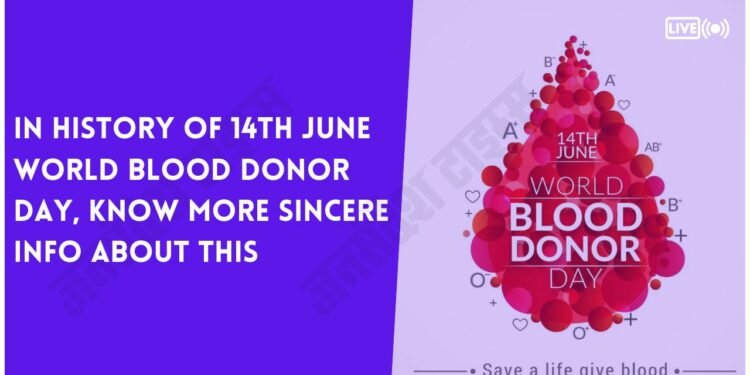Highlights
World Blood Donor Day is an annual observance held on June 14th to raise awareness about the importance of safe blood donation and to thank blood donors worldwide for their life-saving contributions. It serves as an opportunity to promote voluntary unpaid blood donation and highlight the need for regular blood donations to ensure the availability of safe and quality blood and blood products for transfusion.
World Blood Donor Day was established by the World Health Organization (WHO) in 2004 as a response to the need for more voluntary blood donors and to acknowledge and appreciate those who donate blood regularly. Each year, the day is celebrated with a specific theme that focuses on different aspects of blood donation.
The primary goals of World Blood Donor Day are to:

- Raise awareness: The day aims to inform people about the importance of voluntary blood donation and the impact it can have on saving lives. It seeks to dispel myths and misconceptions about blood donation and encourage more individuals to become regular blood donors.
- Appreciate blood donors: World Blood Donor Day provides an opportunity to express gratitude to blood donors worldwide who selflessly donate blood to help others. It acknowledges their contributions and encourages them to continue their support.
- Promote safe blood donation practices: The day emphasizes the importance of safe blood donation practices, such as proper screening of donors, testing for infectious diseases, and ensuring the quality and safety of donated blood and blood products. It also encourages the establishment and maintenance of well-organized blood transfusion services.
- Mobilize more blood donors: World Blood Donor Day aims to mobilize more individuals to become regular blood donors, especially voluntary unpaid donors. It encourages governments, health organizations, and communities to organize blood donation drives and campaigns to increase the availability of safe blood.
On this day, various events and activities are organized worldwide to mark the occasion. These can include blood donation drives, seminars, conferences, health fairs, and educational programs to raise awareness about blood donation and its impact on saving lives.
Remember, blood donation is a simple and safe process that can make a significant difference in the lives of those in need. If you are eligible, consider donating blood and contributing to the noble cause of saving lives.
Raise awareness of World blood donors:
Raising awareness about blood donation is crucial to ensure a steady and sufficient supply of safe blood for those in need. Here are some key points to help raise awareness about blood donation:
- Importance of blood donation: Educate people about why blood donation is essential. Explain how donated blood is used in medical treatments, surgeries, emergencies, and for individuals with certain medical conditions. Emphasize that donated blood can save lives and improve health outcomes.
- Regular blood donation: Highlight the need for regular blood donations. Blood has a limited shelf life, and regular donors are necessary to maintain a stable blood supply. Encourage individuals to become regular blood donors by emphasizing that it is a safe and painless process.
- Voluntary unpaid blood donation: Emphasize the importance of voluntary unpaid blood donation. Clarify that voluntary donors are not paid for their blood, ensuring the safety and integrity of the donated blood supply. Counter misconceptions that may exist about blood donation and address any concerns potential donors might have.
- Eligibility and screening: Inform people about the eligibility criteria for blood donation, such as age, weight, and health requirements. Explain the screening process involved, including medical history questions and testing for infectious diseases, to ensure the safety of both donors and recipients.
- Community involvement: Encourage community engagement in blood donation initiatives. Partner with local organizations, schools, universities, workplaces, and community centers to organize blood drives and awareness campaigns. Collaborate with healthcare providers, blood banks, and relevant authorities to facilitate and promote blood donation.
- Social media and online platforms: Leverage the power of social media and online platforms to spread awareness. Share stories of individuals whose lives have been saved through blood donation. Post informative content, infographics, and videos about the importance of blood donation. Utilize hashtags and online campaigns to reach a wider audience.
- Collaboration with healthcare professionals: Work closely with healthcare professionals, including doctors, nurses, and other medical staff, to promote blood donation. Encourage them to discuss blood donation with their patients and provide information about local blood donation centers.
- Public events and campaigns: Organize public events, campaigns, and awareness programs centered around blood donation. Host seminars, workshops, and panel discussions featuring medical professionals and blood donation experts. Use these platforms to address common questions, concerns, and misconceptions related to blood donation.
- Personal testimonials: Encourage individuals who have donated blood or received blood transfusions to share their stories. Personal testimonials can have a powerful impact in motivating others to become blood donors. Highlight the positive experiences and the sense of fulfillment that comes from helping others.
- Partnerships with media: Collaborate with local media outlets, such as newspapers, radio stations, and television channels, to raise awareness about blood donation. Seek opportunities for interviews, articles, and public service announcements to reach a wider audience and promote blood donation campaigns.
Remember, raising awareness about blood donation requires consistent efforts and collaboration from various stakeholders. By working together, we can encourage more individuals to become regular blood donors and save countless lives.
Appreciating blood donors is essential to recognize their selfless contributions and encourage continued support. Here are some ways to show appreciation to blood donors:
- Thank you notes: Send personalized thank-you notes or cards to blood donors expressing gratitude for their generosity and life-saving contributions. Acknowledge the impact they have made and emphasize the difference they have made in the lives of patients in need.
- Donor recognition events: Organize special events to honor blood donors. Host appreciation ceremonies, award ceremonies, or donor recognition dinners where donors are publicly acknowledged and appreciated for their contributions. Invite local dignitaries, healthcare professionals, and community members to show their support.
- Donor Stories: Share inspiring stories of blood donors and recipients. Highlight the real-life experiences of individuals who have benefited from blood donations and showcase how donors’ contributions have made a positive impact. This helps create a personal connection and encourages others to donate.
- Social media shout-outs: Utilize social media platforms to publicly recognize blood donors. Post photos, testimonials, or short videos featuring donors and their experiences. Use hashtags and mentions to give them a special shout-out and encourage others to follow their lead.
- Donor certificates and badges: Provide donors with certificates or badges of appreciation for their commitment to blood donation. These can serve as tangible reminders of their contributions and act as symbols of honor and pride.
- Donor-exclusive perks: Offer special perks or benefits to blood donors as a token of appreciation. This could include priority access to health screenings, discounts at partner establishments, or exclusive invitations to donor-only events. Such incentives can motivate donors to continue their support and encourage others to join.
- Donor testimonials: Request donors to share their experiences and testimonials about blood donation. Encourage them to talk about why they donate, how it makes them feel, and the impact they believe they are making. Publish these testimonials on your organization’s website, social media channels, or newsletters to inspire others to get involved.
- Volunteer opportunities: Provide opportunities for donors to become volunteers within your blood donation organization. This allows them to further contribute to the cause and engage in meaningful activities. Recognize their efforts as volunteers and express appreciation for their continued dedication.
- Public recognition: Work with local media outlets to feature stories of blood donors. Encourage newspapers, radio stations, and television channels to interview donors or publish articles about their contributions. This helps raise awareness and publicly acknowledges their generosity.
- Continuous communication: Maintain regular communication with blood donors to keep them informed about the impact of their donations. Share updates on the number of lives saved, stories of successful transfusions, and the ongoing need for blood. This ensures that donors feel connected and valued.
Remember, expressing appreciation to blood donors is not just a one-time gesture but an ongoing effort. Regularly remind them of the positive difference they make and encourage their continued support.
Promote safe blood donation practices:
Promoting safe blood donation practices is crucial to ensure the quality and safety of donated blood and protect the health of both donors and recipients. Here are some ways to promote safe blood donation practices:
- Donor screening: Emphasize the importance of thorough donor screening processes. Highlight that potential donors are carefully evaluated to identify any risk factors that may affect the safety of donated blood. Explain the significance of screening questions related to medical history, lifestyle, and travel to assess eligibility and identify potential infections.
- Testing for infectious diseases: Educate potential donors about the rigorous testing procedures conducted on donated blood. Emphasize that all donated blood is tested for various infectious diseases, including HIV, hepatitis B and C, syphilis, and others. Assure donors that any blood found positive for infectious diseases is appropriately discarded to ensure the safety of recipients.
- Adherence to standard operating procedures: Emphasize the importance of following standard operating procedures (SOPs) during the entire blood donation process. Stress that strict adherence to SOPs, including proper hand hygiene, use of sterile equipment, and aseptic techniques, is essential to prevent contamination and maintain the safety of donated blood.
- Trained healthcare professionals: Highlight the role of trained healthcare professionals in blood donation centers. Explain that experienced phlebotomists and medical staff handle the blood collection process to ensure its safety. Encourage potential donors to have confidence in the expertise and professionalism of the healthcare team.
- Proper donor care: Promote the concept of donor care during and after blood donation. Inform donors that their well-being and comfort are prioritized throughout the process. Stress that reputable blood donation centers provide appropriate post-donation care, including rest, refreshments, and monitoring for any adverse reactions.
- Donor eligibility guidelines: Educate potential donors about the eligibility guidelines for blood donation. Explain that these guidelines are in place to safeguard the health of both the donor and the recipient. Emphasize that individuals who do not meet the eligibility criteria should refrain from donating blood to maintain safety standards.
- Donor confidentiality: Assure potential donors that their personal and medical information is treated with strict confidentiality. Emphasize that this confidentiality is maintained to respect their privacy and ensure their trust in the blood donation process.
- Quality assurance measures: Highlight the quality assurance measures implemented by blood donation centers. Explain that these measures include regular internal and external audits, accreditation processes, and adherence to national and international standards to ensure the highest levels of quality and safety in blood transfusion services.
- Donor education materials: Provide educational materials to potential donors that explain safe blood donation practices, including brochures, pamphlets, posters, and online resources. These materials should cover important topics such as eligibility criteria, the screening process, testing procedures, and post-donation care.
- Continuous training and updates: Stress the importance of continuous training and education for healthcare professionals involved in the blood donation process. Highlight that regular training sessions and updates on best practices and new developments in blood transfusion services help ensure the ongoing safety and quality of donated blood.
Remember, promoting safe blood donation practices requires ongoing vigilance, adherence to guidelines, and continuous education. By prioritizing safety, we can instill confidence in potential donors and ensure the well-being of both donors and recipients.
Mobilize more blood donors:

Mobilizing more blood donors is crucial to meet the constant demand for a safe and adequate blood supply. Here are some strategies to help mobilize more blood donors:
- Public awareness campaigns: Launch targeted public awareness campaigns to educate the general public about the importance of blood donation. Utilize various channels such as social media, television, radio, and print media to reach a wide audience. Highlight the impact of blood donation on saving lives and emphasize the ongoing need for donors.
- Collaborate with community organizations: Partner with local community organizations, clubs, religious institutions, and other community groups to organize blood drives and awareness events. Engage community leaders and influencers to promote blood donation and encourage their members to participate.
- Corporate partnerships: Forge partnerships with businesses and corporations to organize blood donation drives at workplaces. Encourage companies to support blood donation by providing time off for employees to donate, offering incentives, or organizing on-site blood donation facilities. Promote the idea of corporate social responsibility and the positive impact of supporting blood donation initiatives.
- Educational institution’s involvement: Collaborate with schools, colleges, and universities to engage young people in blood donation. Organize awareness sessions, workshops, and blood drives on campuses. Foster a culture of giving back to the community among students and motivate them to become regular blood donors.
- Blood drives in public spaces: Organize blood donation drives in public spaces such as shopping malls, community centers, and recreational areas. Set up mobile blood donation units to facilitate convenient and accessible opportunities for individuals to donate blood.
- Engage with healthcare professionals: Collaborate with healthcare professionals, including doctors, nurses, and medical staff, to promote blood donation. Encourage them to discuss the importance of blood donation with their patients and advocate for blood donation within their networks.
- Peer-to-peer campaigns: Encourage existing blood donors to become ambassadors for blood donation. Encourage them to share their positive experiences and the impact they have made. Utilize their stories and testimonials to inspire others and create a sense of social responsibility.
- Use technology and social media: Leverage technology and social media platforms to reach a wider audience and engage potential donors. Utilize online platforms to promote blood donation campaigns, share information, and provide easy registration and appointment systems for blood donation.
- Government support and policy advocacy: Collaborate with government health authorities to advocate for policies that support and promote blood donation. Advocate for the allocation of resources and infrastructure to ensure the availability of well-equipped blood donation centers and services. Work with policymakers to establish a conducive regulatory environment that encourages voluntary blood donation.
- Donor retention strategies: Implement donor retention strategies to encourage regular blood donation. Establish donor loyalty programs that recognize and appreciate regular donors. Provide ongoing communication and updates on the impact of their donations, and create a sense of belonging to a community of donors.
Remember, mobilizing more blood donors requires a multi-faceted approach involving collaboration with different stakeholders, strategic partnerships, and effective communication. By raising awareness, engaging communities, and making blood donation accessible, we can increase the number of donors and ensure a steady supply of safe blood for those in need.
The first blood donor?
The first recorded blood donor in history is not definitively known due to the lack of detailed historical records. However, the practice of blood transfusion has ancient roots. The earliest known accounts of blood transfusion date back to the 17th century. One notable figure associated with early blood transfusion experiments is Richard Lower, an English physician who conducted experiments on animals in the 1660s.

The first successful documented human blood transfusion was performed by Dr. James Blundell, an English obstetrician, in 1818. He successfully transfused blood from one patient to another to treat postpartum hemorrhage. Dr. Blundell’s work paved the way for further advancements in the field of blood transfusion.
It is important to note that the concept of blood donation as we understand it today, where individuals voluntarily donate blood for the purpose of helping others, emerged in the early 20th century. The development of safe and effective blood donation techniques, including the use of anticoagulants and blood typing, played a significant role in establishing blood donation as a standard medical practice.
The first blood bank
The first blood bank, as we understand it today, was established by Dr. Bernard Fantus in 1937 at the Cook County Hospital in Chicago, United States. Dr. Fantus is widely credited with pioneering the concept of a blood bank and developing the techniques for storing and preserving donated blood for later use.

Dr. Fantus recognized the need for a centralized supply of blood that could be readily available for transfusions during medical emergencies and surgical procedures. He introduced the concept of collecting, testing and storing donated blood in a controlled environment to ensure its safety and availability when needed.
At the Cook County Hospital, Dr. Fantus established a dedicated space, equipped with refrigeration units, to store donated blood. He implemented procedures for blood typing, cross-matching, and proper handling to ensure compatibility between donors and recipients.
The establishment of the first blood bank revolutionized medical care by providing a reliable source of blood for transfusions, reducing the reliance on immediate direct donors for emergency situations. Dr. Fantus’s pioneering work laid the foundation for the development of blood banking systems around the world, saving countless lives through the availability of safe and matched blood for transfusions.



